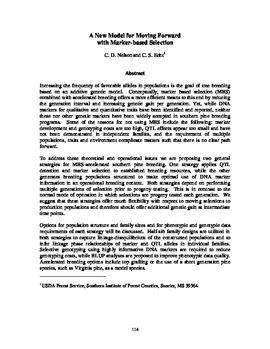| dc.contributor.author | Nelson, C. D. | |
| dc.contributor.author | Echt, C. S. | |
| dc.date.accessioned | 2016-04-25T19:36:00Z | |
| dc.date.available | 2016-04-25T19:36:00Z | |
| dc.date.issued | 2003 | |
| dc.identifier | oksd_sf27_p114.pdf | |
| dc.identifier.citation | Nelson, C. D., & Echt, C. S. (2003). "A New Model for Moving Forward with Marker-based Selection." In 27th Southern Forest Tree Improvement Conference, Stillwater, OK | |
| dc.identifier.uri | https://hdl.handle.net/11244/33675 | |
| dc.description.abstract | Increasing the frequency of favorable alleles in populations is the goal of tree breeding based on an additive genetic model. Conceptually, marker based selection (MBS) combined with accelerated breeding offers a more efficient means to this end by reducing the generation interval and increasing genetic gain per generation. Yet, while DNA markers for qualitative and quantitative traits have been identified and reported, neither these nor other genetic markers have been widely accepted in southern pine breeding programs. Some of the reasons for not using MBS include the following: marker development and genotyping costs are too high, QTL effects appear too small and have not been demonstrated in independent families, and the requirement of multiple populations, traits and environment complicate matters such that there is no clear path forward. To address these theoretical and operational issues we are proposing two general strategies for MBS-accelerated southern pine breeding. One strategy applies QTL detection and marker selection to established breeding resources, while the other generates breeding populations structured to make optimal use of DNA marker information in an operational breeding context. Both strategies depend on performing multiple generations of selection prior to progeny testing. This is in contrast to the normal mode of operation in which selections are progeny tested each generation. We suggest that these strategies offer much flexibility with respect to moving selections to production populations and therefore should offer additional genetic gain at intermediate time points. Options for population structure and family sizes and for phenotypic and genotypic data requirements of each strategy will be discussed. Half-sib family designs are utilized in both strategies to capture linkage-disequilibrium of the constructed populations and to infer linkage phase relationships of marker and QTL alleles in individual families. Selective genotyping using highly informative DNA markers are required to reduce genotyping costs, while BLUP analyses are proposed to improve phenotypic data quality. Accelerated breeding options include top grafting or the use of a short generation pine species, such as Virginia pine, as a model species. | |
| dc.format | application/pdf | |
| dc.language | en_US | |
| dc.relation.ispartofseries | Sponsored publication . . . of the Southern Forest Tree Improvement Committee ; no. 49 | |
| dc.rights | This paper is made available through open access and the auspices of the fair use doctrine for scholarly, educational and research purposes while recognizing the publisher already offers a free online version. The OSU Library�s intent is to offer access and preserve publications involving its faculty contributions. Contact the Digital Resources and Discovery Services at lib-dls@okstate.edu or 405-744-9161 for the permission policy on the use, reproduction or distribution of this material. | |
| dc.source | Proceedings of the 27th Southern Forest Tree Improvement Conference, volume 27, 2003. Editor, Craig R. McKinley. | |
| dc.title | New Model for Moving Forward with Marker-based Selection | |
| dc.type | text | |
| osu.filename | oksd_sf27_p114.pdf | |
| dc.type.genre | Conference proceedings | |
| dc.description.scopeandcontents | Papers and abstracts from the 27th Southern Forest Tree Improvement Conference held at Oklahoma State University in Stillwater, Oklahoma on June 24-27, 2003. | |
